Intel’s Sandy Bridge i7-2820QM: Upheaval in the Mobile Landscape
by Jarred Walton on January 3, 2011 12:00 AM EST- Posted in
- Laptops
- Intel
- Sandy Bridge
- Compal
Temperatures and Noise
Wrapping up our look at the Compal notebook, we measured the noise levels and temperatures at idle and at load. Since we don’t know if this particular configuration will even hit retail, we won’t dwell on it too much, but here are the results. Idle surface temperatures measured between 24C and 29C on the keyboard and palm rest, while the bottom of the notebook is slightly warmer and showed temps of 26-32C. Most of the notebook is close to room temperature, but near the CPU and exhaust at the back/middle the system is a bit warmer. Under heavy load (for over an hour), the temperatures increase, but the fan and dynamic CPU/GPU clocks keep things reasonable. The top temperatures increased to 24-33C, while the bottom measured 26-38C. Temperatures at the exhaust under load were around 44C. Here’s a shot of internal system temperatures, courtesy of HWMonitor.
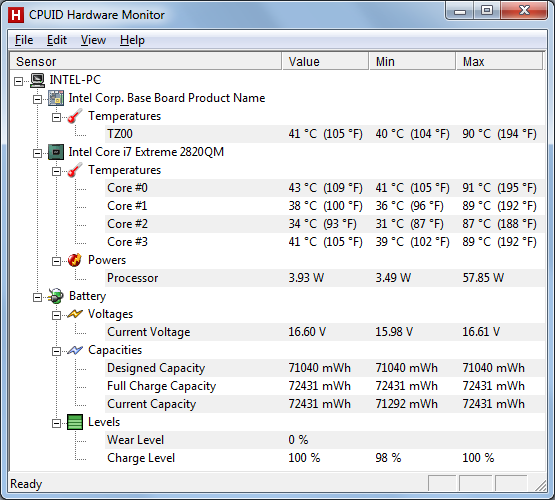
Using the same idle and load tests, we also checked noise levels. The BIOS on this particular setup allows you to configure two temperatures and fan speeds, with the defaults being 75% fan speed at 55C and 100% fan speed when the CPU hits 70C. There are apparently other settings in effect, however, as we noticed four distinct fan speeds. Anyway, below about 45C, the fan shuts off and you have a silent notebook. Given the low power requirements and CPU temperatures at idle, the system fan is usually off under light loads, with the result being system noise right at the floor of our testing environment/equipment: 30dB. Occasionally the fan will spin up and create about 32.5dB of noise, but this usually only lasted a few seconds at most. Running heavy loads will usually get the fan at maximum speed after 20 seconds or so, at which point we measured 41dB; that’s still tolerable considering how infrequent such loads usually are, though if you do heavy number crunching or video editing you might end up with a moderately noisy notebook.
Average Resolution, Average Performance
What about the LCD? We’ve only looked at a few 17.3” notebooks, with their associated 900p resolution. So far we’ve had the Clevo W870CU (Chi Mei N173O6-L02), the ASUS X72D/K72DR with the same panel, and the Dell Studio 17 (with an unknown panel). The Sandy Bridge test system apparently comes with a Seiko Epson 173KT panel, but the characteristics are no better—and sometimes worse—than the other 17.3” 900p displays we’ve looked at.

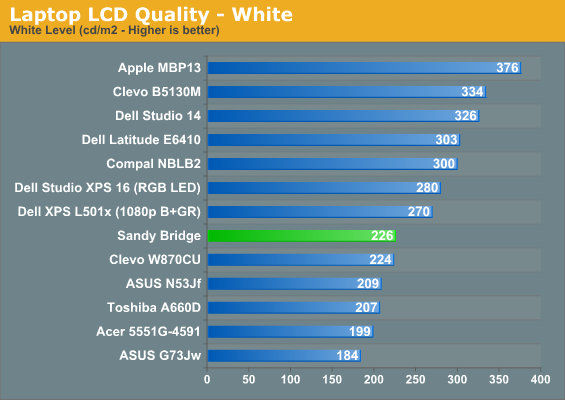
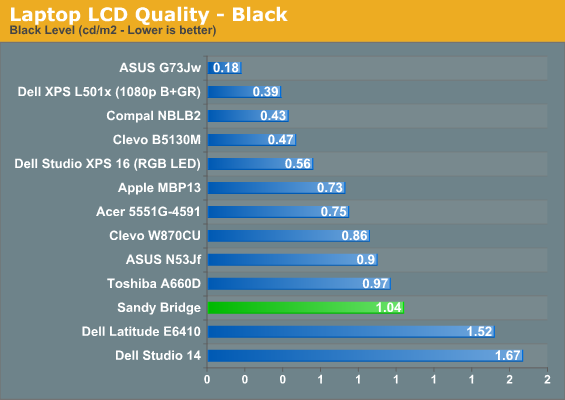

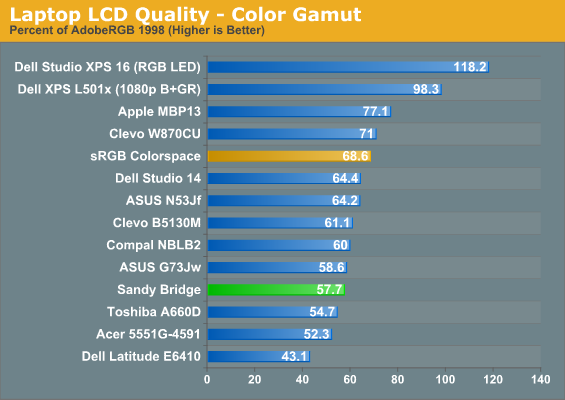
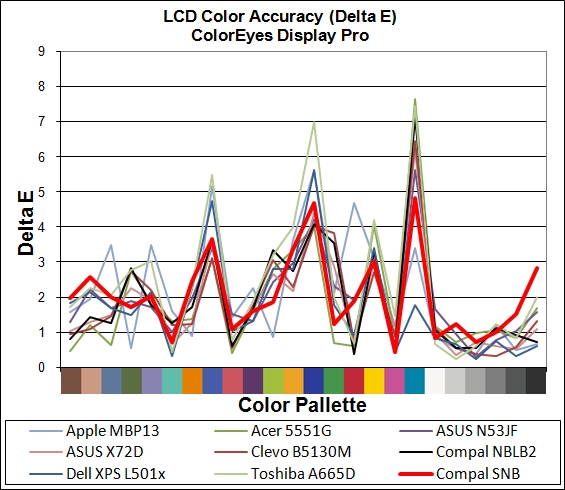
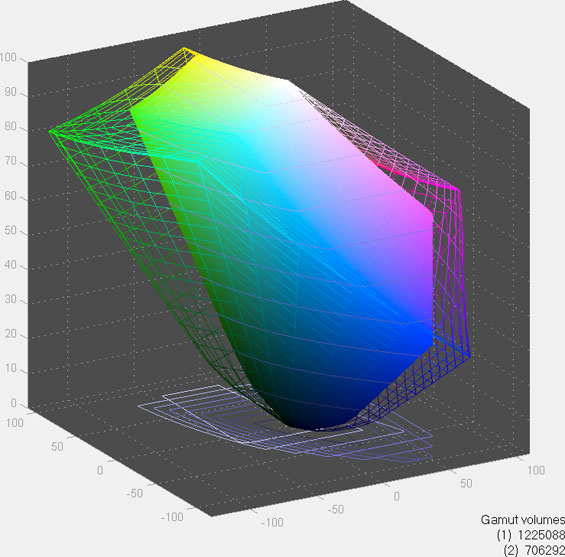
Color gamut is pretty good, and accuracy is perhaps a bit better than average, but the contrast is a disappointing 217:1 and the maximum brightness is a none-too-impressive 226nits. While there are certainly worse LCDs out there, this particular panel is yet another that fails to rise above mediocrity. We have yet to test a 900p display that has impressed us, so consider this a warning.










66 Comments
View All Comments
skywalker9952 - Monday, January 3, 2011 - link
For your CPU specific benchmarks you annotate the CPU and GPU. I beleive the HDD or SSD plays a much larger role in those benchmarks then a GPU. Would it not be more appropriate to annotate the storage device used. Were all of the CPUs in the comparison paired with SSDs? If they weren't how much would that affect the benchmarks?JarredWalton - Monday, January 3, 2011 - link
The SSD is a huge benefit to PCMark, and since this is laptop testing I can't just use the same image on each system. Anand covers the desktop side of things, but I include PCMark mostly for the curious. I could try and put which SSD/HDD each notebook used, but then the text gets to be too long and the graph looks silly. Heh.For the record, the SNB notebook has a 160GB Intel G2 SSD. The desktop uses a 120GB Vertex 2 (SF-1200). W870CU is an 80GB Intel G1 SSD. The remaining laptops all use HDDs, mostly Seagate Momentus 7200.4 I think.
Macpod - Tuesday, January 4, 2011 - link
the synthetics benchmarks are all run at turbo frequencies. the scores from the 2.3ghz 2820qm is almost the same as the 3.4ghz i7 2600k. this is because the 2820qm is running at 3.1ghz under cinebench.no one knows how long this turbo frequency lasts. maybe just enough to finish cinebench!
this review should be re done
Althernai - Tuesday, January 4, 2011 - link
It probably lasts forever given decent cooling so the review is accurate, but there is something funny going on here: the score for the 2820QM is 20393 while the score for the score in the 2600K review is 22875. This would be consistent with a difference between CPUs running at 3.4GHz and 3.1GHz, but why doesn't the 2600K Turbo up to 3.8GHz? The claim is that it can be effortlessly overclocked to 4.4GHz so we know the thermal headroom is there.JarredWalton - Tuesday, January 4, 2011 - link
If you do continual heavy-duty CPU stuff on the 2820QM, the overall score drops about 10% on later runs in Cinebench and x264 encoding. I mentioned this in the text: the CPU starts at 3.1GHz for about 10 seconds, then drops to 3.0GHz for another 20s or so, then 2.9 for a bit and eventually settles in at 2.7GHz after 55 seconds (give or take). If you're in a hotter testing environment, things would get worse; conversely, if you have a notebook with better cooling, it should run closer to the maximum Turbo speeds more often.Macpod, disabling Turbo is the last thing I would do for this sort of chip. What would be the point, other than to show that if you limit clock speeds, performance will go down (along with power use)? But you're right, the whole review should be redone because I didn't mention enough that heavy loads will eventually drop performance about 10%. (Or did you miss page 10: "Performance and Power Investigated"?)
lucinski - Tuesday, January 4, 2011 - link
Just like any other low-end GPU (integrated or otherwise) I believe most users would rely on the HD3000 just for undemanding games in the category of which I would mention Civilization IV and V or FIFA / PES 11. This goes to say that I would very much like to see how the new Intel graphics fares in these games, should they be available in the test lab of course.I am not necessarily worried about the raw performance, clearly the HD3000 has the capacity to deliver. Instead, the driver maturity may come out as an obstacle. Firstly one has to consider the fact that Intel traditionally has problems with GPU driver design (relative to their competitors). Secondly, should at one point Intel be able to repair (some of) the rendering issues mentioned in this article or elsewhere, notebook producers still take their sweet time before supplying users with new driver versions.
In this context I am genuinely concerned about the HD3000 goodness. The old GMA HD + Radeon 5470 combination still seems tempting. Strictly referring to the gaming aspect I honestly prefer reliability and a few FPS' missing rather than the aforementioned risks.
NestoJR - Tuesday, January 4, 2011 - link
So, when Apple starts putting these in Macbooks, I'd assume the battery life will easily eclipse 10 hours under light usage, maybe 6 hours under medium usage ??? I'm no fanboy but I'll be in line for that ! My Dell XPS M1530's 9-cell battery just died, I can wait a few months =]JarredWalton - Tuesday, January 4, 2011 - link
I'm definitely interested in seeing what Apple can do with Sandy Bridge! Of course, they might not use the quad-core chips in anything smaller than the MBP 17, if history holds true. And maybe the MPB13 will finally make the jump to Arrandale? ;-)heffeque - Wednesday, January 5, 2011 - link
Yeah... Saying that the nVidia 320M is consistently slower than the HD3000 when comparing a CPU from 2008 and a CPU from 2011...Great job comparing GPUs! (sic)
A more intelligent thing to say would have been: a 2008 CPU (P8600) with an nVidia 320M is consistently slightly slower than a 2011 CPU (i7-2820QM) with HD3000, don't you think?
That would make more sense.
Wolfpup - Wednesday, January 5, 2011 - link
That's the only thing I care about with these-and as far as I'm aware, the jump isn't anything special. It's FAR from the "tock" it supposedly is, going by earlier Anandtech data. (In fact the "tick/tock" thing seems to have broken down after just one set of products...)This sounds like it is a big advantage for me...but only because Intel refused to produce quad core CPUs at 32nm, so these by default run quite a bit faster than the last gen chips.
Otherwise it sounds like they're wasting 114 million transistors that I want spent on the CPU-whether it's more cache, more, more functional units, another core (if that's possible in 114 million transistors) etc.
I absolutely do NOT want Intel's garbage, incompatible graphics. I do NOT want the addition complexity, performance hit, and software complexity of Optimus or the like. I want a real GPU, functioning as a real GPU, with Intels' garbage completely shut off at all times.
I hope we'll see that in mid range and high end notebooks, or I'm going to be very disappointed.